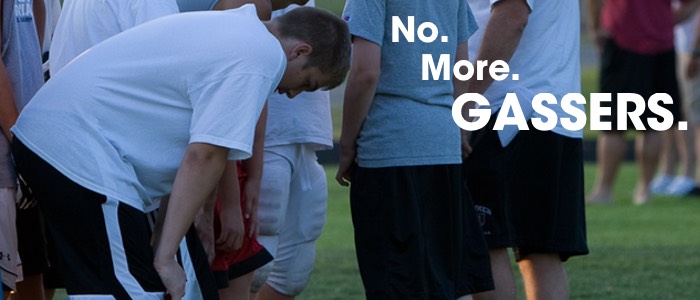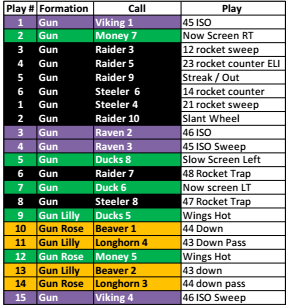Stop Running Gassers (or, Better Ways to Condition in Youth Football)

I talked a bit about my approach to conditioning in my Installing the Wing-T post and thought it would be helpful to go into more depth on specifics. I’ll also cover some of the hurry-up and two-minute drill work that we do.
I credit Dave Cisar for giving me a serious attitude adjustment regarding conditioning about 6–7 years ago. Dave says:
We don’t do any of the old-fashioned conditioning or agility drills. We can condition just as well by running our plays out 20 yards or doing rapid-fire pursuit or kick-off and punt coverage drills.
This was a big eye opener for me, and went against everything I had been taught and everything I saw happening around me. Intuitively it made sense though, and I was able to convince my co-head coach to collaborate with me on transforming our practice approach. We gradually eliminated wind sprints and gassers and focused instead of running a fast-paced practice and designing drills specifically to keep the kids moving and simulate game situations.
On-Air Plays

The simplest thing you can do is run plays on-air with consistent expectations and coaching. Here’s how we do it:
- Our teams are usually sized such that we can build two complete offensive groups. Sometimes we’ll break this into 1s and 2s, sometimes we will balance the two groups (so each of the two groups will have equal mix of starters and backups). Mix it up as you want the kids used to playing with different players. Also, know what your groups are before practice starts! You don’t want to be standing around picking players during practice. This wastes time.
- Depending on how much space you have, how old your kids are, and how hard you want to work them, set cones anywhere from 20 to 40 yards out from the line of scrimmage, which will be the same for every play. If you have players that will need to play in both groups (maybe your backup right guard is out and you need your starter to play with group 1 and 2), setup another cone half the distance out.
- Use a play call script like the one shown above. Focus on the plays and formations you are trying to emphasize that practice. It could be the subset you plan to run against your next opponent, or it could be a new series you are installing. Again, you don’t want to be improvising and coming up with plays on the fly. This will also help ensure that you spread the ball around and mix in your running and passing game.
- You need to decide up front if you are running plays for fast repetition and conditioning, or if you will be evaluating execution and coaching the kids. If you are running fast, let the kids make mistakes but keep the intensity up. You can talk about problems or corrections after you are done with the drill session, but don’t slow down the drill in progress. Make sure all of the assistants are clear as well!
- We pretend every play goes for a touchdown and hence the need for all players to run out to the marker. Once past the target cone, players peel off to the sideline and continue running to prepare to come to the line after the second squad executes. Players doing double duty just run halfway then sprint back to join the other squad.
Bandit Drill
My favorite way to end practice when we are in full or thud contact mode is the Bandit Drill. I created a quick reference guide to the Bandit Drill to help out - this shows using a half field which is usually the most I ever had to work with. I learned it after hearing it mentioned in a podcast and watched Barry Creviston’s Youtube video. Here’s my brief summary:
- You’ll want to split your team into two approximately equal teams. Because you will favor the offensive side of the ball, you might end up with a bit of a hodgepodge defense. I’ve found kids usually don’t mind this (D linemen getting to play linebacker, etc.). Again, chart this out ahead of time and don’t waste time picking teams during practice.
- You can either run your own defense and make it a competitive offense vs. defense drill, or you can have the defense get into your next opponent’s base defense to give the offense a look like they’ll see in their next game.
- Script out at least two sets of 9 plays to call (one for each team). If you will repeat the drill you can script out a few other sets or just reuse the ones you already made.
- Setup flat cones from the 45 yard line down to the 5 yard line, and zig-zag between the hashes and middle of field. If you are running this full field, you can start at your own 10 yard line and do 10 yard increments.
- Run your hurry-up offense and time each squad from their first snap to hopefully scoring a touchdown on their last play in the red zone. We use a quick whistle and quickly have the ball placed at the next cone. Pass plays that can get down-field will draw this drill out a bit so you might want to stick to the running game plus short pass plays.
- I think it takes three coaches to run this drill properly: one to call the plays, one to spot the ball, and one to be on the whistle and retrieve the ball for the spotter. This is also a great drill for the coaches as they get more accustomed to calling plays in a high intensity, high speed situation.
- Consider penalizing the offense in time (e.g., 10 seconds per incident) for penalties (false start will be the most common) or turnovers.
- Keep score and reward the winning team. Keeping it competitive will help keep the kids focused and working hard. With my 8th graders we would usually get through the 9 plays in a half-field setup in about 2 minutes.